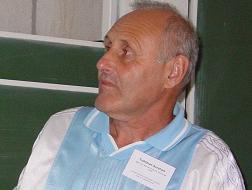Penniless migrant becomes a maths superstar

A 63-year-old mathematician who worked as a labourer and night-watchman when he first migrated to Israel from Russia has solved a problem which has taxed the world's leading experts in his field for more than a generation.
Avraham Trakhtman has ended the mystery of the Road Colouring Problem by proving the theory of a "universal map" which allows a journey to end at a certain destination whatever the starting point by following the same instructions.
Professor Trakhtman of Bar-Ilan University managed to jot down the proof in pencil on eight pages of paper. In layman's terms, the problem – in the field of symbolic dynamics – can be expressed as whether a man who arrives in a city without street names to visit a friend and telephones for help, could be given directions which would work wherever he was at the time. The solution – which appears to defy logic but which mathematicians believe could have real-life applications in mapping and computer sciences – has excited widespread interest and admiration among Professor Trakhtman's international peer group.
It is all the more remarkable since Professor Trakhtman, who came from Sverdlosk (now Yekaterinburg) in the Urals as a Jewish immigrant to Israel, has achieved the triumph of his career at an age well beyond that at which mathematicians are normally expected to reach their peak.
The Road Colouring Problem was originally posed in 1970 by Benjamin Weiss, an Israeli-American mathematician, and Roy Adler, who both worked at the computer giant IBM. They posited that, given a finite number of roads, they could be depicted in a colour-coded map that would lead to the same destination regardless of the point of origin. Around 100 experts, including the authors of the proposition, have attempted to produce a proof but all failed.
In a diagrammatic version of the conjecture – now a theorem thanks to Professor Trakhtman – a 16-line graph forming one square and eight triangles, with the lines coloured red or green, includes two vertices, each representing different destinations. Following the route "blue red red" repeated three times always leads to one, and following "blue, blue red" always leads to the other, whatever the starting point.
Stuart Margolis, who recruited Professor Trakhtman to Bar Ilan, near Tel Aviv, told Associated Press: "In math circles, we talk about beautiful results – this is beautiful and it is unexpected. Even in layman's terms it is completely counterintuitive, but somehow it works."
Professor Margolis said that the discovery was all the more remarkable given Professor Trakhtman's age and background. "The first time I met him he was wearing a night watchman's uniform," he said.
Professor Trakhtman said that it took him a year to solve the problem. But he insisted to AP: "The solution is not that complicated. It's hard, but it is not that complicated. Some people think they need to be complicated. I think they need to be nice and simple."
Benjmain Weiss said that it gave him great joy to see someone solve his problem, adding that Professor Trakhtman's solution "is something that is understandable."
Subscribe to Independent Premium to bookmark this article
Want to bookmark your favourite articles and stories to read or reference later? Start your Independent Premium subscription today.

Join our commenting forum
Join thought-provoking conversations, follow other Independent readers and see their replies